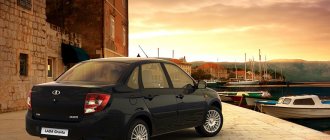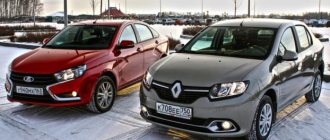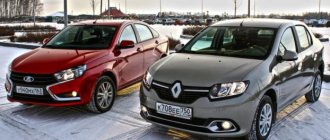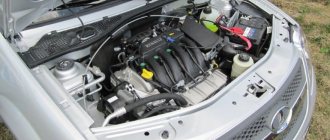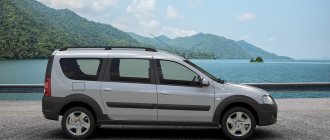It is no secret that the LADA Largus model, which rolled off the factory assembly line back in 2011, is a modified station wagon of French origin, the Renault Logan MCV. And this is no coincidence, because the “French”, thanks to its outstanding consumer qualities, has deservedly gained popularity not only in Europe, but also in Russia.
Here the buyer has the expected question: has the Largus model become better than its famous ancestor? Next, we will try to understand this aspect using specific examples. Let's try to find out which of the presented cars is better: Renault Logan or Lada Largus. To do this, let's make a comparison.
Renault Logan 2 or Lada Largus choice
Many people ask to share their impressions of Largus and compare them with Logan.
Well, in fact, Largus is a Dacia Logan MCV, i.e. There are not many differences with my Logan and some of them are: novelty, body type and equipment. Here are all the main differences =) I drove all modifications of Logan, from my 1.4 to my friend’s 1.6 16V.
Let's start the comparison with “Novelty”.
It is rightly said that a good car is a new car, this is true.
Largus is very interesting to drive, I was a little confused that the gas pedal is very sensitive, and the brake pedal is not as crazy as on Logans - this is definitely a plus.
The steering is very informative and soft, there are no differences from Logan. The engine is pleasantly responsive, it’s very pleasant to drive, it accelerates briskly.
I was also pleased with the gearbox, it is the same as on the Logans - smooth and soft, the gears shift clearly and it feels like the lever stroke is a little shortened compared to the Logans. It also seemed to me that first gear has become longer, you can not only start in it, but also accelerate.
The Largus's suspension is moderately stiff, it absorbs potholes like "Hurrah!", the car corners perfectly, better than my Logan =)
It seems to me that all my comments are a sign of novelty, and not technical improvements by Russian engineers.
I have a traditional Logan sedan, well, few others drive in Russia. Well, what can you compare here? Largus is huge compared to my Logan =) 7 seats and one lie-down in the trunk =) The station wagon, I thought, would be more clumsy than the sedan, but I didn’t notice a big difference.
My Logan 1.4 is the first generation, it has a basic configuration, i.e. there is nothing in it. Largus 1.6 16V has a luxury package and a similar interior to the second generation Logan, however, the plastic elements of the interior seem to be made in Russia. There is no point in describing what Largus is rich in - it is on the main page of the blog.
Let me summarize: Largus and Logan are similar in many ways, but there are also small pleasant differences. Largus is undoubtedly better than my Logan in all respects! True, in most respects it is similar to any second-generation Logan. Largus is good - this is what I, my dad and many Largus owners say, but Largus is the same Logan =)
Despite the fact that the manufacturer positions the Lada Largus as a completely new and independent model, at its core it represents a slightly modified Renault Logan MCV station wagon, which was popular in many countries around the world, including Russia. Whether such borrowing is bad or good is up to everyone to decide for themselves - some will not like copying other people’s ideas, even if officially permitted, while others will rejoice at the use of time-tested technologies. Considering that the Renault station wagon can still be bought in Russia, it will be interesting to know which is better - Logan or Largus? It is worth remembering that the car produced by VAZ underwent modifications before being put on the production line - many motorists want to find out what it was.
And again we compare the Lada Largus
Nissan Almera
Nissan Almera produced by the Tolyatti Automobile Plant is a significantly redesigned “Japanese” Nissan Blubird Sylphy of the 2005 model year, built on the same B0 platform as Logan. Nissan Almera produced by the Tolyatti Automobile Plant is a significantly redesigned “Japanese” Nissan Blubird Sylphy of the 2005 model year, built on the same B0 platform as Logan.
It’s funny that at the presentation of the new Almera, Nissan representatives stubbornly classified it as segment B - although the previous Almera (in the N16 body) competed well with golf-class models. But the VAZ sedan is longer than the three-volume Ford Focus and inferior to the Volkswagen Jetta by a few millimeters!
Car appearance
It would be more correct to start the comparison with a station wagon from Russia, because this particular car is positioned as an alternative to the “French”.
Exterior and characteristics of Lada Largus and Renault Logan
Initially, the Russian car was modified to take into account the harsh conditions of our winters. In addition, the manufacturer applied special treatment to prevent corrosion of individual elements. The anti-corrosion layer is mainly used on the underbody and wheel arches. The thickness of the coating is approximately 5 mm thicker in comparison with Logan. The anticorrosive layer contains components that increase resistance to sudden temperature changes and the negative effects of various chemical reagents used to treat road surfaces.
Many note a more attractive exterior in comparison with Renault Logan. The paintwork on both cars is of high quality, the paint is resistant to chips, abrasions, etc. The overall dimensions of both of them - the Renault Logan or the Lada Largus - are approximately the same. The French station wagon has a length of 4492 mm, while the Lada Largus has 4470 mm. The width, height and wheelbase of the cars are virtually identical.
Largus has the advantage of protective linings on the arches. Moreover, these elements can be installed even in the basic configuration. Renault Logan does not have this. Largus is protected from gravel and small dust particles by rear pads. Additionally, there is an anti-gravel coating over a large area. The Frenchman cannot boast of this. Renault does not have a rear windshield wiper; Largus already has this useful accessory.
In general, the cars are similar in terms of trunk volume and other parameters, but if we consider the appearance, the domestic station wagon still looks more attractive.
Lada Largus Cross or Renault Duster
What's better? They differ from each other much more than in the case of Logan. Largus is a real station wagon, and Renault Duster in its all-wheel drive version was created as an off-road conqueror. The front-wheel drive version also shows good results on poor road surfaces thanks to its high ground clearance. Many may reasonably note that the Duster cannot be called a full-fledged SUV, but the versatile Largus can also cope with minor off-road conditions thanks to its increased ground clearance. But we are talking about comparing the basic capabilities of cars in everyday use, and not about the potential in exceptional cases.
Comparison with closest competitors
- Kia Sportage or Renault Duster
- Nissan Qashqai or Renault Duster
- Renault Duster or Lada X-RAY
- Renault Duster or Niva Chevrolet
- Lifan X60 or Renault Duster
- Renault Duster or Renault Sandero Stepway?
- Renault Duster or UAZ Patriot?
- Mitsubishi ASX or Renault Duster
- Renault Duster or Skoda Yeti
- Chery Tiggo or Renault Duster?
Choosing which coolant is better to fill in Renault Logan: antifreeze or antifreeze?
It seems like the Lada Largus is nothing like the reviews, but after the Kalina I have confidence in Ladas somehow…. it's called paranoia) So Duster.
You know, I hear and read very bad reviews of the French. Renault, Peugeot - that's the only way they break down. Imported cars are more reliable. Renault, of course, inspires more trust. As a girl, design really excites me.
I don’t understand why ours still can’t create normal cars, like the Europeans, so that we can really compare.
I agree with you, Alexey. Of course Duster. Our cars are bought only by poverty and the village with loans, because they are not given money for a normal car. This is how our auto industry still rests #128578;
If you want to support a domestic manufacturer, then fine, otherwise they are about the same.
For the most part, VAZ manufactures its cars based on this particular French comrade. I have sufficient operating experience as a product from VAZ and Renault. The cars are in completely different class categories. If you choose between Largus and Duster, then definitely Duster. Comfort, design, quality, horsepower - these are only a small part of how the Duster is superior to Largus
Interior
The French station wagon wins in terms of interior appearance: richer equipment, better quality materials, as well as a multimedia system with a large monitor. The highlight of the Renault Logan MCV is the basic offer, which can be installed for an additional fee:
- side airbags;
- alloy wheels;
- multimedia navigation system.
It should be noted that there is good visibility from the inside, thanks to the voluminous side mirrors. Regarding the dimensions of the luggage compartment, the Frenchman is also in the lead here: 573 liters versus 560 liters for the Russian. In turn, the Lada Largus boasts a more comfortable interior, as well as more space in the rear seats, which will significantly affect the comfort of passengers, especially on long trips. The Lada package also includes alloy wheels, ABS, front airbag and climate control for an extra charge.
Comparison of configurations
In terms of comfort, Largus beats Duster and even Logan. The “French” have practically nothing in the basic configuration, and the difference in finishing materials is insignificant. Duster and Logan can be supplemented with several options in the minimum configuration:
- light alloy cast wheels;
- navigation;
- side airbags;
- heated side mirrors.
Depending on the configuration, the Lada Largus can also be supplemented with some options, including:
- airbags;
- air conditioning system;
- navigation;
- alloy wheels, etc.
In terms of cost, Lada Largus is traditionally a favorite, because it is cheaper than Logan (after restyling) and Duster in basic trim levels by an average of 100,000 rubles. The difference is not very big, so all these cars can be safely considered in the same price category.
What engines are on the Lada Largus?
The Largus is equipped with a 1.6-liter engine, which, on the one hand, has established itself as a relatively reliable unit. On the other hand, due to the maximum economy with which it was created, it requires a lot of attention and maintenance. The motors are not quiet and smooth and, despite the same volume, operate differently. We'll tell you which Largus engine is better.
Until 2012, Largus were equipped with engines from Logan: 1.6 liters with a power of 84 or 102 hp. With. With timely replacement of spark plugs, oil with filters and timing belt, French engines run up to 150 thousand km. The belt lasts up to 120 thousand km, and replacing it costs about 4 thousand rubles.
Modern Largus are equipped with Russian 8- or 16-valve engines with a volume of 1.6 liters and a power of 87 or 106 horses. In these engines, special attention should be paid to the condition of the timing belt, which lasts up to 60 thousand km. If it breaks, the valve will bend. In addition, the hydraulic compensators that regulate the valves are not provided in the engine, so this will have to be done at a service center at least every 30 thousand km.
Also, Russian engines have problems with throttle valve failure and frequent failure of certain sensors. In terms of noise and vibration levels, domestic engines are also inferior to French ones.
With foreign engines, French gearboxes were installed in Largus. A five-speed manual transmission lasts up to 200 thousand km, and the clutch lasts about as long as the gearbox itself. A new one will cost 4.5 thousand rubles, and the cost of the box itself starts from 70 thousand rubles. Automatic transmission has never been installed on Largus.
Lada Largus Cross
Finally, for commercial transportation there is a van - and for economical ones, AVTOVAZ is developing a version with a bi-fuel engine that can run on both gasoline and methane.
Most passable
The Renault Duster crossover embodied the dreams of those for whom the capabilities of the UAZ Patriot seemed excessive, and the Chevrolet Niva was not satisfied with its low-power engine. The relatively affordable all-terrain vehicle began to be assembled at the Moscow plant in 2011, with a two-year lag behind its Romanian counterpart. At first, all-wheel drive versions (front-wheel drive versions are also available) were offered only with a manual transmission, but then - especially for us! — for the 4x4 versions, the four-speed automatic DP8 was adapted.
Is Largus a copy of Logan?
Experts note that the Lada Largus is an almost complete clone of the Renault Logan. True, there are some nuances in cars that distinguish them. More on this below.
Exterior
Rear seats (Renault Logan edition)
If you examine Logan from the outside, you may not notice the details in which it differs from Largus. Externally, the cars are almost identical. But inside the cabin, changes are immediately noticeable. All of them are in favor of Lada.
Salon Lada Largus
The driver can sit comfortably behind the wheel in one or another car. The seats can be adjusted in different positions.
The disadvantages of Renault include some small details, for example, the heater control is located too low. (Renault Logan editors)
To adjust, you will need to take your eyes off the road. Also, with the rear row seats folded down, the car becomes too noisy.
Otherwise there are no differences. The handling of the car is the same, the landing too. The build quality is good, as are the ergonomics. The only difference between the cars is the cost.
Service
It should be noted that most Renault owners “get” some little things. For example, the backlighting of the buttons often burns out. When contacting a service station, it turns out that the entire button must be replaced, since the diode cannot be replaced separately.
In winter there are no problems with both cars. They start the first time. Here you just need to monitor the quality of the fuel. The suspension is good; unscheduled replacements of its elements will not be required during normal operation.
Specifications
Both cars can be equipped with a range of engines, which include both diesel and petrol units. They can work in tandem with mechanics or automation. Drive – front. The engine power in both cars is enough for comfortable movement on the highway and in the city. The cost of spare parts will be cheaper for Lada, which is its advantage over Renault.
Results
Which car to choose is up to you. Here you need to take into account your capabilities and the conditions in which you plan to operate the car.
Comparison of technical characteristics
Replacing ball joints on Renault Logan: video and which ones are better
To answer this important question, you should compare Renault Docker or Lada Largus by assessing the technical characteristics of the cars. Their dimensions are approximately the same. The length/width/height of the French car is 4363x1751 and 1852 mm, and the Russian one is 4470/1750/1670 mm. You can notice that the Russian minivan is slightly longer and lower than the French one. True, these differences are almost invisible and do not affect performance. Renault Docker has a ground clearance of 190 mm that is truly impressive for its class. This is quite enough not only for driving on bad roads, but also for overcoming very impressive off-road obstacles. For his opponent, this figure is noticeably more modest - only 145 mm. Therefore, a Russian is most likely not suitable for trips to the country or nature. Its ground clearance is too low for this and there is a risk of damage to suspension elements.
Despite the fact that the cars are quite simple and budget-friendly, they have the necessary minimum set of options that are responsible for comfort and safety. For such machines, nothing more is required. At the same time, all devices and systems are reliable and perfectly tuned for Russian operating conditions.
Interior of Lada Largus and Renault Logan
Regarding the external appearance of the cabin space, you can notice that in the interior Logan looks more attractive than its Russian competitor. The “European” materials are of higher quality and more pleasant to tactile manipulation. The level of equipment with comfort options is higher, which is confirmed by the multimedia complex with a large display.
The basic configuration of the “French” can be supplemented with the following options for an additional fee:
- side pillows;
- light alloy wheels;
- navigation system.
Side mirrors allow drivers of both station wagons to have good visibility.
Next up is luggage compartments. Logan’s capacity turned out to be better, because 573 liters of usable space left behind the competition of 560 liters that the Russian model can offer. Almost the same volume, so it’s difficult to choose which is better: Renault Logan or Lada Largus.
Largus “wins back” thanks to a more spacious interior. There is more room for the legs of passengers in the stern, so on long trips they are certainly endowed with sufficient comfort.
The Lagrus package also provides the possibility of installing alloy wheels, an ABS system, a driver airbag and an air conditioning system. Naturally, all this is available for some additional payment. We continue the comparison in an attempt to determine which is better than Renault Logan or Lada Largus.
Comparison of configurations
In terms of comfort, Largus beats Duster and even Logan. The “French” have practically nothing in the basic configuration, and the difference in finishing materials is insignificant. Duster and Logan can be supplemented with several options in the minimum configuration:
- light alloy cast wheels;
- navigation;
- side airbags;
- heated side mirrors.
Depending on the configuration, the Lada Largus can also be supplemented with some options, including:
- airbags;
- air conditioning system;
- navigation;
- alloy wheels, etc.
In terms of cost, Lada Largus is traditionally a favorite, because it is cheaper than Logan (after restyling) and Duster in basic trim levels by an average of 100,000 rubles. The difference is not very big, so all these cars can be safely considered in the same price category.
Differences between domestic and French models
Let's start with the Russian station wagon. Note that the designated car was initially conceived and designed taking into account the severity of the domestic climate. Separately, we note the level of anti-corrosion treatment of body elements. The protective layer on the bottom and in the Largus arches is 5 mm thicker compared to the protection in Logan. The treatment composition includes substances that exhibit increased resistance to temperature fluctuations and the effects of aggressive road reagents.
If we compare, the interior ventilation system in Lada is more efficient, which allows you to heat the interior faster in cold weather. In general, the heating system on both station wagons is quite reliable and does not bother owners with malfunctions. Sometimes you can hear complaints about insufficient fan performance from owners of 7-seater versions of Logan MCV. The situation changes dramatically in favor of the “French” in the summer. Its climate control turned out to be more effective than similar equipment in Largus. We continue the comparison, choosing between Renault Logan or Lada Largus.
Cost of ownership
And finally, let’s compare the cost of CASCO. To do this, we use existing online calculators, and as a starting point we will take cars worth 650 thousand rubles, which in Moscow will be driven by a 50-year-old married man with two children and 30 years of driving experience. As a result, the price of insurance against theft/damage risks, depending on the insurance company and the type of policy for Lada Largus 2021 vs Renault Logan 2021 cars, is as follows:
- Renaissance Insurance “Professional support” - 12,901 rub. vs RUR 22,798;
- Zetta Insurance “Not at fault” - 14,300 rub. vs RUB 24,050;
- Liberty Insurance "CASCO Direct" - 45,020 rub. vs RUR 42,010;
- MAX "Premium" - 51,100 rub. vs 69,100 rub. respectively.
In general, as we see, an insurance policy will cost more for the French model in almost all companies.
Main Differences
If we start with the Russian station wagon, it should be noted that the car was originally designed for the harsh climate of the country. The anti-corrosion treatment of the body on Largus, which is 5 mm thicker in contrast to its French counterpart, deserves special attention. It includes components that are more resistant to temperature changes, as well as protected from the effects of aggressive chemicals. The Lada also has more efficient airflow, which has a positive effect on the climate inside the cabin, especially in the cold season. The Renault plant installs a reliable electric heating system on the MCV model, however, in the Russian cold it is not always enough, especially in the 7-seater version of the Frenchman.
Summary
Lada Largus 2021 model year is an inexpensive multifunctional car that enjoys well-deserved popularity among car owners. But if you don't need a vehicle to transport 7 people or bulky cargo, then the Renault Logan 2021 deserves no less consideration. The “French” will delight you with its low price, dynamic characteristics, lower gas consumption, the presence of options that the opponent does not have, and the possibility of purchasing a version with an automatic transmission. The purchase of one of these two models is largely determined by its purpose. As for the demand for these cars this year, in the first five months of 2021 the following were sold: Largus - 19,696 units, Logan - 13,401 units, that is, the French sedan has reduced the gap with the Russian station wagon.
Main Differences
In particular, AvtoVAZ launched the production of a car that is fundamentally different from all previous models. This year, the AvtoVAZ family was supplemented by a station wagon with increased spaciousness and European comfort. It turns out that the car that Russian motorists have been waiting for so long has been born.
Especially those who have a large family. The car has recently been put into mass production; despite its youth, it already has its own history of creation. Below you can find out how Largus was created.
It is on the basis of this car that the VAZ Largus was created. Dacia Logan MCV appeared before the public as a roomy and comfortable station wagon, a car for the whole family.
Then the car was produced in Romania and characterized itself positively during operation.
All suites come with valves and 2 interior styles. So far these are the only ones that exist. In general, the cheapest Largus will cost thousands of rubles for a passenger station wagon and for a van, but the production of such modifications has not even begun. It is difficult to buy Largus now. Dealers have a queue of people, but cars arrive a week.
AvtoVAZ plans to have a capacity of more than a thousand cars per year, but so far there are problems with the painting booth. Because of this, queues form, and the excitement for the new product affects it. Largus - flesh on flesh Logan.
Same design, platform, driving habits, omnivorous engines, bump-absorbing suspension. The performance characteristics are the same, only Largus has a larger trunk, some versions have a third row of seats, and fuel consumption is higher, which is normal, given the increased weight. At the same time, a richly equipped Largus costs a little less than a similar Logan, perhaps it will be a little cheaper to operate, in particular, it should have VAZ standard hours, although spare parts and consumables will be unified in price with Logan.
The only possible stumbling block is reliability and build quality. There is already one alarm bell here. Several people on the unofficial forum of brand lovers immediately reported that they could not start the car with kilometers on it.
We managed to find out the reason quickly - it turned out that the wire to the solenoid relay on the starter had shorted to the motor: The number of complaints suggests that this is not an isolated case, but a factory defect. How is Lada Largus different from Renault Logan? We received the car in early September, but we had to get in line in the spring. The car itself is a Renault Logan converted into a station wagon. More details 2 Despite the fact that the manufacturer positions the Lada Largus as a completely new and independent model, at its core it represents a slightly modified Renault Logan MCV station wagon, which was popular in many countries around the world, including Russia.
Whether such borrowing is bad or good is up to everyone to decide for themselves - some will not like copying other people’s ideas, even if officially permitted, while others will rejoice at the use of time-tested technologies.
Considering that the Renault station wagon can still be bought in Russia, it will be interesting to know which is better - Logan or Largus? I try to do my own repairs on my cars!
Comparative review from me Lada Largus is interesting to drive. The gas pedal in the car is quite sensitive. The brake pedal also responds well, but not as well as on the Logan, which is an advantage of the latter. Regarding the steering, it should be noted that there is not much difference between these cars. The only difference is the range of engines that cars can be equipped with.
Such cars are pleasant to drive, as they accelerate quite quickly. The gearbox shifts smoothly and smoothly.
Motor
Today, Vesta is equipped with only one engine, while the Renault line is represented by two power units. Nevertheless, the domestic engine outperforms both French versions in terms of power. However, its dynamics are not so good.
The base Logan is equipped with an 8-valve engine with a volume of 1.6 and a distributed fuel injection system. However, its maximum return does not exceed:
- 82 horsepower;
- 5,000 rpm.
With a top speed of 172 kilometers, the car accelerates to hundreds in 11.9 seconds. All this is ensured by relatively high fuel consumption. In the city, the car consumes up to 9.8 liters, on the highway – up to 5.8.
Logan's second power plant is 16-valve, power – 102 horsepower. At the same time, the maximum speed is only 5750. Acceleration to hundreds occurs in 10.5 seconds, and the speed limit is 180 kilometers. In urban conditions, the engine consumes 9.4 liters, and on the highway - 5.8.
Vesta manufacturers equip the car with a 16-valve 1.6-liter engine. Its parameters:
- power – 106 horses;
- rpm – 5,800.
The domestic car accelerates to 100 kilometers in 11.8 seconds. In the city, fuel consumption is 9.3 liters, and on the highway – 5.5.
Thus, it turns out that Vesta will have to give up the championship to Logan in this category. The situation, however, may change when the plant implements its plans to equip the Lada with a 110 hp Renault Nissan engine. With. or domestic at 122 horsepower. It is also known that VAZ designers are actively working on creating their own budget power plant with 82 hp. With. So in the future, Vesta will definitely take the lead.
- five-speed manual transmission;
- robotic gearboxes (type – AMT).
Moreover, Lada’s first option is better. The unit is perfectly assembled and operates as clearly as possible. In Logan, while driving, the gearshift lever vibrates noticeably.
The AMT quality of both cars is identical.
Where the Frenchman has an advantage is in the modern 4-speed automatic transmission. The machines equipped with it operate much smoother than the vehicles on which the robot is mounted. However, due to the fact that Logan is a budget solution, Renault did not consider it possible to install a 5-position transmission on it, and therefore a sedan with an automatic transmission is seriously inferior to its brother with an ATM when driving on the highway.
In the future, it is likely that the precarious balance will be upset in favor of Vesta, since they plan to install a variator on it. Logan has no chance of anything like this.
Offer for sale
New offers from sellers
No offers from car dealerships
New cars on AUTO.RIA
Cookies “For the convenience of using the site and all services, we use cookies.
To learn about types of cookies
and configure them,
click "Customize" or check out
"Cookie Policy"
.
I accept all settings
Cookie settings “We (ARS ONLINE OÜ) use cookies that are required for the operation of our website and services, based on legitimate interest. Also, with your consent, we would like to install optional analytical cookies on your device to remember data about browsing and use of services, as well as marketing cookies that will help us understand which services and products interest users most.
By turning on these cookies, you help improve our services and products. Read more about cookies in our Cookies Policy. We install mandatory cookies in any case. Below you can choose whether or not to allow us to install optional cookies."
Save
Let's sum it up
1. Renault Logan MCV. This is a fairly comfortable station wagon that is perfect for urban everyday use. The car will delight you with a spacious trunk, high-quality interior panels and a large list of comfort and safety options. A good advantage of the “French” is the presence of a diesel power plant.
Disadvantages include weak adaptation to Russian climatic factors and higher maintenance costs.
2. LADA Largus. If we compare, this is a model that is more successfully adapted to harsh operating conditions. The body has better protection against corrosion and chemically active environments.
Among the disadvantages are the poor interior equipment and the poor quality of the trim panels.
Concluding the review, choosing which is better from the presented Renault Logan or Lada Largus cars, let’s say that the question of choosing the optimal option from the presented two related station wagons is of a purely individual nature. Every practical owner will like one or another option, since both models have plenty of them. In general, with proper use, the Renault Logan or LADA Largus station wagons “hold up with dignity” and do not cause angry criticism from the owners.
Will you pay extra for clearance?
With a 105-horsepower engine and a manual transmission (there are no other options), Largus Cross costs 614,500 rubles, and for a 7-seater saloon you will be asked to pay an additional 25 thousand. Expensive? But at the same time, the queue for a car lasted for 2-3 months. Kalina Cross is much more affordable: 485,400 rubles for the 87-horsepower version and 495,300 for the 106-horsepower version. There is also a special offer for city residents: with a “robot” and a powerful engine, a raised station wagon will cost 516,700 rubles.
There are few alternative options to Ladam. Renault Sandero Stepway (82 hp) for 569,000 will be frankly “empty” - you’ll even have to pay extra for air conditioning. The basic Lifan X50, which “Auto Mail.Ru” recently became acquainted with, attracts with its rich equipment, but is also not cheap - 500 thousand. Should I pay extra and get a Duster? But this is only the “advertising” basic version costs 599,000, and the real one costs more than 730,000, and this is for a car with front-wheel drive and without air conditioning. If you need a “budget” SUV, then look towards the Chevrolet Niva - from 539 thousand.
Photo by Pavel Murashko and Olga-Anna Kanashits
From your aluminum
The H4M engine was almost completely localized at AvtoVAZ - even the cylinder blocks and heads are cast in Tolyatti from domestic aluminum. Therefore, the additional payment for a fresh engine is modest - 15 thousand rubles , no matter what configuration of Logan or Sandero you choose. Moreover, you cannot recognize “sports” Renaults without an analysis under the hood - they have no external signs.
Although our couple already stands out - with crossover features: high ground clearance, plastic shields... Off-road brutality is in fashion now, but for the same money - almost 700 thousand rubles - the Lada has a "vintage" B0 platform without a system wrapped in it stabilization and with the only old 102-horsepower K4M engine. And the Sandero Stepway is more progressive in terms of its filling: it is built on a modernized M0 “trolley” and is equipped with an H4M engine with 113 horsepower. Experience versus youth?
At the same time, the raised hatch and station wagon agree on bad roads - they don’t care about bumps and holes ! Moreover, Largus Cross does this with particular cynicism, only swaying arrogantly on particularly large potholes. Sandero Stepway on exactly the same wheels with Continental ContiPremiumContact5 tires of size 205/55 R16 rolls on the broken surface a little more densely. No, no, and vibration will run through the body, interior plastic will crunch...
Passport details
| Model | Lada Largus CNG | Renault Dokker Stepway 1.5 DCI |
| * Data in parentheses are for the methane version. | ||
| Body | ||
| Body type | station wagon | station wagon |
| Number of doors/seats | 6/5 | 6/5 |
| Length, mm | 4470 | 4390 |
| Width, mm | 1750 | 1767 |
| Height, mm | 1670 | 1857 |
| Wheelbase, mm | 2905 | 2810 |
| Front/rear track, mm | 1469/1466 | 1490/1478 |
| Curb weight, kg | 1450 | 1384 |
| Total weight, kg | 1790 | 1909 |
| Trunk volume, l | 300 | 800–3000 |
| Engine | ||
| Type | gasoline/methane | turbodiesel |
| Location | front, transverse | front, transverse |
| Number and arrangement of cylinders | 4, in a row | 4, in a row |
| Number of valves | 16 | 16 |
| Working volume, cm³ | 1596 | 1461 |
| Max. power, hp/rpm | 106/5800 (94/5800)* | 90/3750 |
| Max. torque, N•m/rpm | 148/4200 (135/4200)* | 200/1750 |
| Transmission | ||
| Transmission | mechanical, five-speed | mechanical, five-speed |
| Drive unit | front | front |
| Chassis | ||
| Front suspension | independent, spring, McPherson | independent, spring, McPherson |
| Rear suspension | semi-independent, spring | semi-independent, spring |
| Front brakes | ventilated disc | ventilated disc |
| Rear brakes | drums | drums |
| Tires | 185/65 R15 | 185/55 R15 |
| Ground clearance, mm | 170 | 190 |
| Performance characteristics | ||
| Maximum speed, km/h | 162 (155)* | 162 |
| Acceleration time from 0 to 100 km/h, s | 13,7 (14,5)* | 13,9 |
| Fuel consumption, l/100 km (cubic m/100 km)* | ||
| — urban cycle | 9,9 (10,5)* | 5,5 |
| - suburban cycle | 6,4 (6,5)* | 4,9 |
| - mixed cycle | 7,7 (8,0)* | 5,1 |
| Toxicity standard | fifth | fifth |
| Fuel tank capacity, l | 50 (90)* | 50 |
| Fuel | AI-92 | diesel fuel |
Granta MiDO Sandero Smily_front
The eight-valve engine with 87 “horses” once again amazed with its elasticity. As a matter of fact: among engines of comparable power, this VAZ unit is the best! Here's how it is: it was not large-scale modifications that turned Kalina into a completely different, much more complete car. And loyal Lada fans have an excellent opportunity to “upgrade” their swallow with original new seats, improve sound insulation and install the correct springs and stabilizers. Tuning to the point - who doesn’t dream about it?
Volkswagen Caddy
Caddy offers a wide choice to the buyer: gasoline or diesel engines, manual or robotic transmission, all-wheel drive or front-wheel drive, a huge range of options, configurations, etc. The variability is several times greater than that of the ascetic LADA Largus, and the average price tag is higher - 604 thousand rubles.
The trunk volume is comparable to Largus's - 530 liters. It is useless to compare the ergonomics and comfort of Caddy and Largus: on all counts, the “German” wins by a huge margin.
If you are ready to overpay almost 170 thousand rubles, choose the seven-seater, spacious, comfortable and variable Volkswagen Caddy. But keep in mind that only every seventh car is given away without problems. Every second one is knocked down and every fifth one is on lease.
As can be seen from this material, Largus is far from the most budget-friendly roomy car. Both Focus and Lacetti will cost less, but will also be able to fit a stroller in the trunk or even a compact refrigerator. But only Largus and Caddy can boast a seven-seater cabin, but the price range between them in the economy segment looks like a yawning chasm. You will have to choose what to prioritize: budget, number of passenger seats, trunk volume or comfort.
If you choose a car based on price, the “universal” version of the Priora will cost the least. If you pay attention only to spaciousness, the leader will be FIAT Doblo. If you need a comfortable, reliable seven-seater with a roomy heel, take a Volkswagen, but budget is out of the equation.
Author: Ekaterina Lipatova
Have you used any car from our selection? What disappointed and pleased you with the car? Write in the comments.
The original article is posted
here .
FIAT Doblo
Fiat Doblo is a step above Largus. It is larger, it is also tailored for practical drivers who are going to use the car as a “workhorse”. At the same time, it costs less than Largus - on average 365 thousand rubles.
Fiat cannot provide a seven-seater cabin, but the volume of the luggage compartment accommodates more luggage than the domestic copy of Dacia Logan - 750 liters versus 560 liters.
Fiat can be safely chosen by those who do not plan to carry five children in the cabin at the same time. It is more suitable for transporting goods. Perhaps it is the “business purpose” of the Fiat Doblo that influences its demand in the secondary market.
Over the past three months, it has been checked only 1,251 times through avtocod.ru. Every third car was sold “clean”. Most of them were sold with estimates for repair work, traffic police restrictions, unpaid fines and road accidents.
There were also leased and low-mileage examples.
Also read:
Business and family Renault Dokker and FIAT Doblo II: what to buy
Equipment
In all respects, with the exception of ground clearance, the cars are absolutely identical.
This model, regardless of what brand it is produced under, was designed on the B0 platform. Dimensions are equal to L-W-H: 4470-1750-1670 mm. The ground clearance varies for the regular version: 175 mm when unloaded, 150 mm when loaded; for the Cross version the ground clearance is 195 mm. The trunk volume is also very variable, from 135 liters in the seven-seater version with the seats folded down. Then 560 in a five-seater, and 2350 liters, although only with two seats. The fuel tank volume for gasoline versions is 50 liters and the gas tank volume is 90 liters for CNG versions. The range of engines is represented by both Renault and AvtoVAZ engines. The weakest in the range is the French-developed inline four, factory code K7M. The volume of this engine, like other Largus engines, is 1.6 liters. Power is around 82 horsepower at 5500 rpm and torque of about 124 Newton meters. Fuel consumption in the combined cycle is 9.3 liters, in the city 12.3, on the highway 7.5.
The second most powerful engine is a Russian one with the same volume and number of cylinders. The VAZ engine code is 11189, essentially the same K7M, only with slightly different attachments and modified engine mounts. Its power has increased to 87 horsepower, and torque to 140 Newton meters.
The third engine is the 1.6 installed on Megan and Logan with sixteen valves and a power of 102 horsepower at 5750 rpm and 148 Newton meters at 3750 rpm. The code for this motor is K4M. Fuel consumption: about 9 liters in the city and 7 on the highway.
The fourth power plant is the VAZ-21129, essentially the same engine as was installed on the Priora, only it complies with Euro-6 emission standards. Power is 106 horsepower at 5800 rpm, torque is 148 Nm at 4200 rpm. The consumption of such an engine in the city is about 11 liters, on the highway 6.4. In the combined cycle, consumption fluctuates between 7-8 liters per hundred. The chassis is presented with an independent McPherson-type suspension with anti-roll bar at the front. At the rear there is a U-shaped beam with programmable deformation zones. The brakes are disc at the front, drum at the rear. Steering mechanism, rack and pinion, at extra cost or in more expensive trim levels with power steering.
